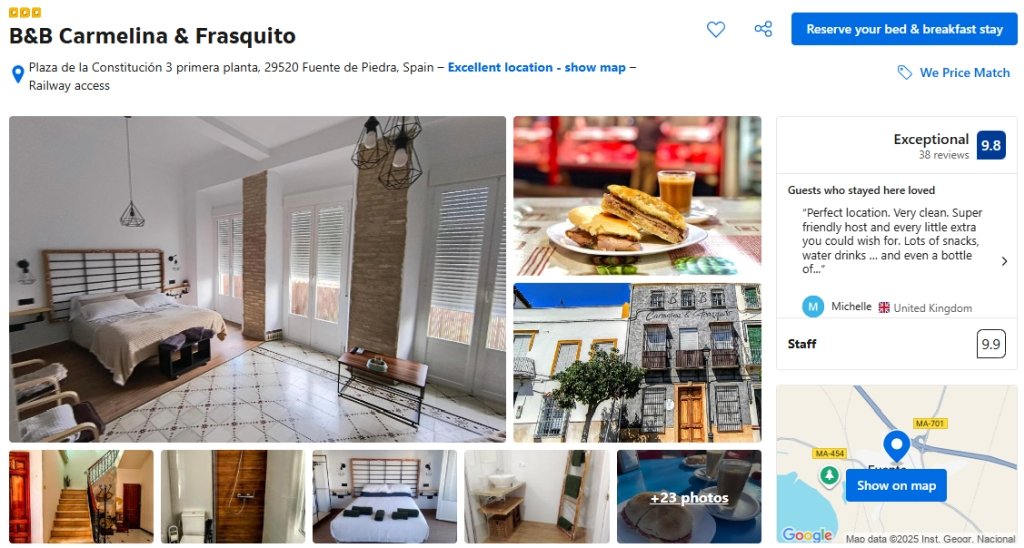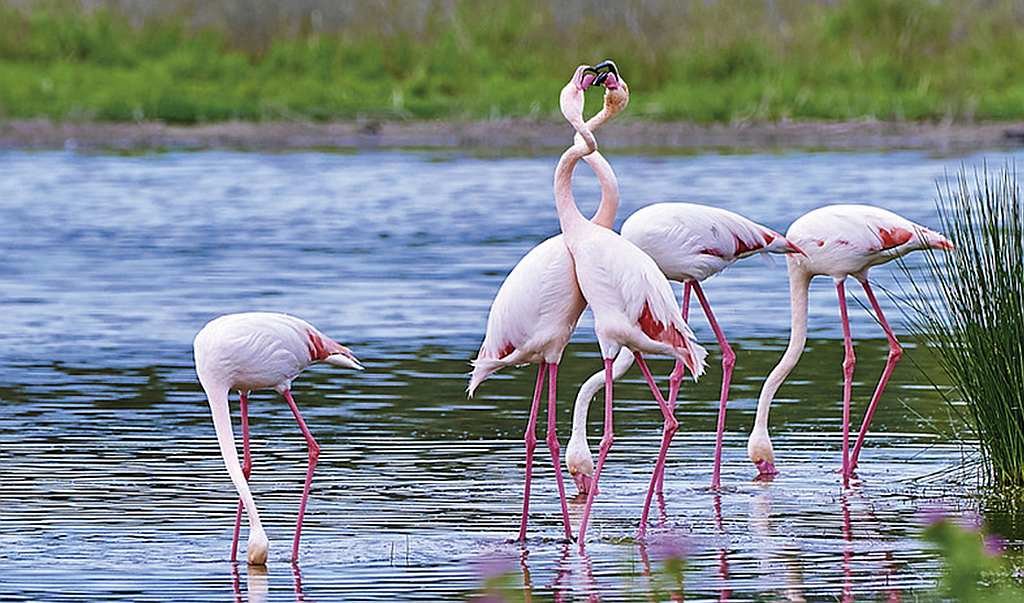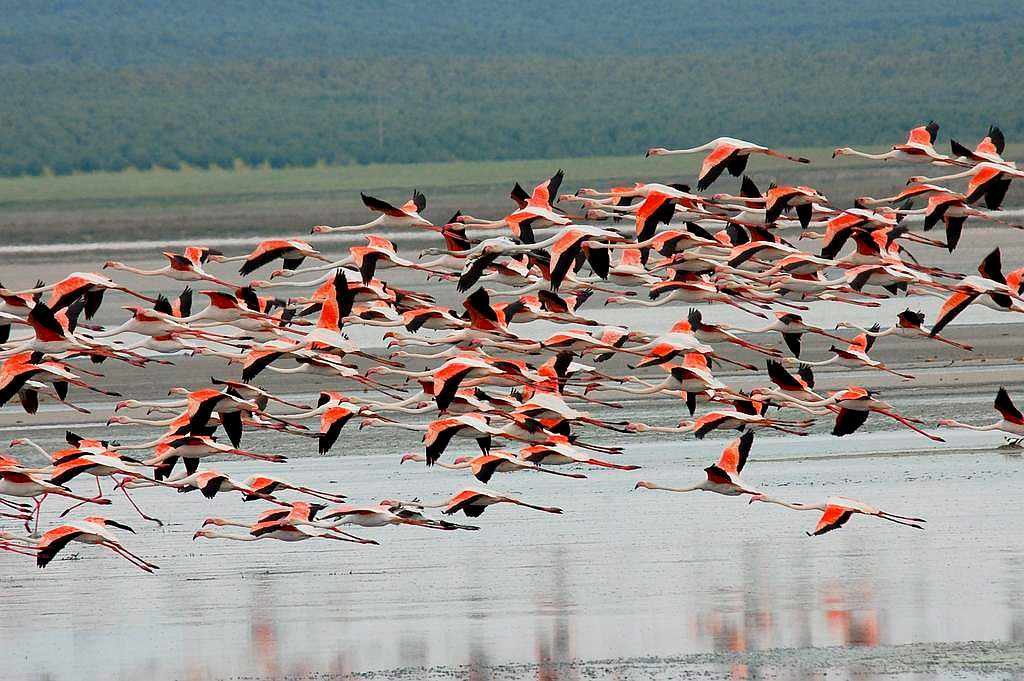Located in the Antequera region of Malaga, Spain, the Fuente de Piedra lagoon is the largest lagoon in Andalusia, stretching 6.5 km in length and 2.5 km in width. This wetland is particularly famous for being home to a large colony of Greater Flamingos, making it a significant site for the species in the Western Mediterranean.
Fuente de Piedra is also included in the list of places to visit close to the Caminito del Rey. https://www.caminodelrey.es/places-to-visit-close-to-the-caminito-del-rey/
Designated as a Ramsar site in 1983, a natural reserve on January 11, 1984, a Special Protection Area for Birds (SPA) in 1988, and a Special Conservation Area (SCA) in 2013, the Fuente de Piedra lagoon covers 1364 hectares of protected land, with 164 hectares forming a part of the natural reserve.
Accommodation in Fuente de Piedra, Andalucía: Where to Stay
Fuente de Piedra, a charming town in Andalucía, Spain, offers a variety of accommodations for every type of traveler. From cozy bed and breakfasts to spacious holiday homes and traditional country houses, visitors can find options that suit both short stays and longer getaways. Many properties are nestled in scenic rural surroundings, while others are conveniently located near the town center, making it easy to explore local attractions.
B&B Carmelina & Frasquito in Fuente de Piedra offers historic charm with family rooms featuring air-conditioning, balconies, private bathrooms, tea/coffee makers, work desks, and free WiFi. Guests enjoy a vegetarian, vegan, and gluten-free breakfast praised for its quality, while amenities include bicycle parking, a tour desk, luggage storage, and soundproofed rooms with city-view balconies.

Nestled within a landscape of olive and cereal fields,
The lagoon is endorheic, supplied by precipitation, runoff, and groundwater, and experiences long periods of flooding followed by drought. Its salinity comes from the salt and gypsum deposits in its basin, which dissolve in the water. During spring, the lagoon dries up, leaving salt to crystallize on its surface. The area is also significant for its salt mining history, with remnants of the canals used for salt sedimentation serving as nesting sites for several bird species.
Situated in the watershed divide between the Guadalquivir river basin (Atlantic slope) and the Guadalhorce river basin (Mediterranean slope), the lagoon is the lowest point in an endorheic or closed drainage basin of approximately 15,000 hectares in area. It has an elliptical shape with a perimeter of 18 km and a water level that typically doesn’t exceed 2 meters.
Geologically, the lagoon is part of the Betic mountain range, located mostly within the Subbetic Zone within the External Zones. The surrounding area is characterized by gentle slopes, with altitudes ranging from 410 meters to a maximum of 434 meters, except for the surrounding mountains. The origin of the lagoon is associated with karstic dissolution and subsidence processes, according to one of the most accepted hypotheses.
The lagoon’s climate is a temperate Mediterranean continental, with a dry season in spring and summer and a season dominated by torrential rains in autumn and winter. The average annual precipitation in the basin is approximately 460 mm/year, with significant interannual variation.
Birdlife around the Fuente de Piedra

The Laguna de Fuente de Piedra is an important nesting, wintering, and migratory passage site for many waterbirds. It is home to the largest colony of Greater Flamingos on the Iberian Peninsula and the second most important in Europe, which can be observed during the nesting period (March-July) along with many other species, such as the Black-winged Stilt, Common Gull, Little Stint, Black-winged Plover, Black-tailed Godwit, and Avocet. During the wintering period (November-February), cranes, ducks such as the Shoveler, and some waders can be observed. During the migratory periods, waders and raptors appear.
A large number of the flamingos reared in the Fuente de Piedra lagoon spend the winter in Morocco, particularly in the estuary of the Muluya River, the coastal lagoon of Mar Chica, or the Souss-Massa National Park. During the chick-rearing period, the feeding areas used by adults are the Cabo de Gata salt flats, the Odiel Marshes and, primarily, the Guadalquivir Marshes.
Monitoring of ringed individuals established that the flamingos that breed in Fuente de Piedra normally feed in wetlands located within a radius of 200 km around the colony.
Information and visitor centres
José Antonio Valverde Visitor Center
Address: Fuente de Piedra. Cerro del Palo, s/n, 29520 (Just follow the signs when you get to Fuente de Piedra.)
Located on a small hill known as Cerro del Palo and overlooking the Laguna de Fuente de Piedra, is the José Antonio Valverde Visitor Center.
Its privileged location, very close to the lagoon, allows for splendid views of the species that frequent it, especially the flamingo. The Visitor Center has a reception area, restrooms, souvenir shop and vending area. It also has 2 free exhibition rooms and a 12-minute audiovisual presentation. You can also rent binoculars and audio guides in different languages.
Opening hours
October 1 to March 31
- Daily, from 10:00 a.m. to 2:00 p.m. and from 4:00 p.m. to 6:00 p.m.
April 1 to September 30,
- Daily from 10:00 a.m. to 2:00 p.m. and from 5:00 p.m. to 7:00 p.m.
Fuente de Piedra Lagoon: Visitor FAQs, Flamingos & Birdwatching Tips
Fuente de Piedra Lagoon lies in the Antequera region of Málaga, Andalusia. It’s about an hour’s drive from Málaga city and close to the Caminito del Rey, making it an ideal stop for nature lovers exploring southern Spain.
The lagoon is home to the largest colony of Greater Flamingos in the Iberian Peninsula, making it one of Europe’s most important flamingo habitats. During spring, thousands of flamingos nest here, creating a spectacular natural display that draws birdwatchers and photographers alike.
Besides flamingos, visitors can spot Black-winged Stilts, Little Stints, Avocets, Common Gulls, and migratory waders and raptors. In winter, cranes and various duck species also frequent the lagoon. For a complete list of seasonal visitors, see the full article.
Fuente de Piedra is an endorheic lagoon, meaning it has no outflow. Its water comes from rainfall, runoff, and groundwater. Salt and gypsum deposits in the basin dissolve in the water, leaving a crystallised salt layer when the lagoon dries, particularly in spring.
Yes — the José Antonio Valverde Visitor Center overlooks the lagoon and provides exhibitions, audiovisual presentations, binocular rentals, and trails for observing wildlife. Its location on Cerro del Palo offers the best vantage point to watch flamingos and other birds.
Spring (March–July) is ideal for seeing flamingos nesting, while winter (November–February) attracts migratory ducks and cranes. Seasonal variations in water levels also affect which species are present, making each visit slightly different.
I’ve been living in this lovely area of Western Andalucia for the last 20 years or so and dedicate most of my time to the running of English language tourist information websites for the towns of Cádiz, Ronda, Grazalema, the famous or infamous Caminito del Rey, and also Wildside Holidays, which promotes sustainable and eco-friendly businesses running wildlife and walking holidays in Spain. My articles contain affiliate links that will help you reserve a hotel, bus, train or activity in the area. You don’t pay more, but by using them you do support this website. Thankyou!

1 thought on “Fuente de Piedra lagoon”